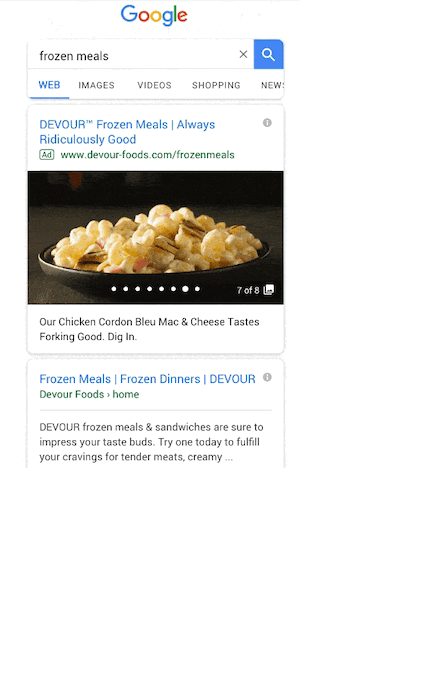It’s well-known that online users respond better to and recall visuals better than text alone. This is perhaps why at Google Marketing Live 2019 the advertising giant made it clear their focus is on visual, top-of-funnel ads.
The approach will not only help them compete with other visual ad platforms like Facebook, Instagram, and Pinterest but will also expand Google’s reach in the discovery phase of the consumer journey.
Following their focus on visual ads, Google announced a new paid search ad type that showcases multiple images on mobile. Think Facebook Carousel Ads but on Google.
Say hello to Google gallery ads.
The ad type is rolling out later in 2019 and will use robust data to match ads with targeted search intent. Prabhakar Raghavan, SVP of Google Ads and Commerce, had this to say about the Google Ads’ new ad format:
By combining search intent with a more interactive visual format, gallery ads make it easier for you to communicate what your brand has to offer.
So, what exactly are Google gallery ads? Let’s find out.
What are Google gallery ads?
Google’s gallery ads are a swipeable, image-based ad format that combines users search intent with related visuals. The ads are shown at the top of SERP and provide better engagement possibilities from potential customers. You can use gallery ads to connect with people before they visit your website or post-click landing page by showcasing lifestyle imagery and brand consistent visual content:

Gallery ads let search users quickly cycle through image cards and allows them to click an ad to expand it into vertical view to view larger. The CTA button that appears at the end of the gallery takes users to the advertiser’s post-click page where they can get more information about the offers in the carousel.
The 9 most important things to know about Google gallery ads
Keep the following things in mind if you’re thinking about using gallery ads in your advertising campaigns.
1. They are shown in the first position on mobile
Currently, gallery ads are only eligible to show on mobile and in the first position in Google search results. Along with swipeable image carousels, ads feature a standard text headline and a display URL.
2. When your gallery ad will show
Gallery ads don’t apply to any specific campaign type. As of now, they run in your search campaign ad groups along with text ads. Gallery ads also compete in the same auction against other text ads.
The ad format only shows one ad at a time, unlike search ads where users see multiple ads at the top of their search screen. The ads will only appear in the top placement of a user’s search results, above any other text ads that may appear following it.
So, gallery ads compete with all other ad formats in an auction as usual. For instance, if you have enabled gallery ads and your bid wins top placement, your gallery ad will be shown. However, If you win the second position or lower on the page, only your text ad will be shown regardless of if you have Gallery Ads in your ad groups.
And if you don’t have gallery ads in your ad groups, but your ad wins the first position in the auction your standard text ad will still be shown in the top position.
3. They are not just for promoting products
Search users turn to Google when they need information, and search ads give them what they are looking for, but in an ad format that could be taxing for them. Since gallery ads are made up of images, online users are more likely to engage with them and recall what they saw.
Based on test performance, ad groups that contain gallery ads are likely to see 25% more interactions than ad groups that only use text ad formats. It’s more likely that a user will swipe through images of a gallery ad, especially if the images are relevant and eye-catching than they are to scan and click a text ad.
Besides promoting products, gallery ads can also help introduce a new product line or tell your brand story. Better yet, try all three approaches and see what resonates most with search users and their intent.
4. They are available in 11 languages
The ad format is available in 11 languages including English, German, Japanese, French, Spanish, Dutch, Portuguese, Italian, Russian, Swedish, and Polish.
5. B2C and B2B brands can both leverage the ad type
Gallery ads’ primary image-centric characteristic makes them a no-brainer for B2C brands. Restaurants can use gallery ads to show scrumptious images of what their menu has to offer, and retail brands can use the ad format to feature multiple products related to the user’s search term.
And though it may not seem like it, B2B brands can also use gallery ads to accomplish the same goals as B2C brands, i.e., narrate their brand story, introduce new products/services, and engage audiences.
Think of it this way; advertisers use LinkedIn, which is a B2B advertising platform to launch image carousel ads that result in higher CTRs. In fact, from 300 advertisers who beta-tested LinkedIn carousel ads, 75% claimed to use them in their next content campaign because they saw a lift in engagement and click-throughs compared to other standard Sponsored Content campaigns.
B2B advertisers can use Google gallery ads the same way, to visually showcase their services and breakdown product benefits with the help of images.
6. Advertisers are charged one of two ways
Depending on the user’s engagement, advertisers are charged by:
- Cost per click: This is the standard way advertisers get charged for search ads, i.e. they have to pay every time a user clicks their ad.
- Cost per swipe: If a search user doesn’t click the ad but swipes through 3 images, the advertiser will be charged. However, advertisers will only be charged once, even if a searcher swipes through 3 images and then clicks the ad. Also, advertisers will only be charged once if the user swipes through more than three images.
7. Character count & ad specs
Similar to Facebook carousel ads, gallery ads contain a static headline and a display URL on top. Advertisers will have the choice to add between 4-8 images with relevant descriptions that users can swipe through to learn more. Each image will have its own tagline and each tagline can be up to 70 characters.
With that many images, this gives you a lot more potential content to play around with. The ad format also allows you to create up to three different headlines that Google selects when displaying your ad, giving advertisers more customization options to test.
8. They are in beta to select advertisers only (for now)
Beginning in August 2019 gallery ads are in beta to select advertisers. However, like many of their previous new ad formats, they will likely be opened up to more and more advertisers with expanded functionality.
9. For best user experience, connect them to AMP pages
Engaging potential customers with gallery ads is just one stop of the conversion journey. To turn the ad click into a conversion, connect the ads with relevant AMP landing pages instead of a product page or your homepage.
Taking users to a dedicated AMP post-click page helps establish message match between what the user sees pre-click and post-click, which is more likely to lead to an advertising conversion.
A personalized post-click landing page will assure users they’ve come to the right place and will give them only the relevant information they need to convert for the offer on the page.
Leverage images in search with gallery ads
Gallery Ads are a unique ad format as they combine the power of search with the potential of image ads, allowing advertisers to get the best of both worlds.
Find out about other ad types and ad specs you can use in your advertising arsenal in the Instapage Digital Advertising Reference Guide. The guide showcases ad dimensions, file formats, sizes, and everything you should know to create compelling ads across all devices and platforms.
